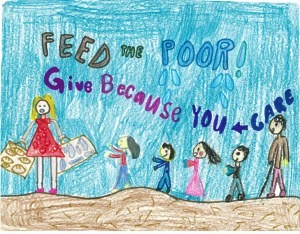The 2016 Feds Feed Families campaign is in full swing and there is still time for you to help make a difference.
What started in 2009 as part of President Barack Obama’s United We Serve campaign to gather nonperishable goods for hungry families has grown into an amazing program collecting almost 52.7 million pounds of food, cleaning and hygiene items. All of these donations are made by federal employees throughout the country.
The USDA leads the way in Feds Feed Families again this year. They have pulled together every federal agency to gather as much nonperishable food and other items that they can. Amazingly, last year the total amount collected came to more than 17.9 million pounds. The Department of Defense played a good role in this by collecting more than 3.2 million pounds of food and hygiene items for the Feds Feed Families program. Almost half of that came from commissary employees and patrons, with donations totaling 1.6 million pounds.
You can make a difference with Feds Feed Families by making a donation of nonperishable food, personal hygiene items and cleaning supplies.
If you need motivation, here are 10 reasons why you should donate items to the Feds Feed Families program.
You wouldn’t allow a child to go hungry. Food banks see a shortage in summer months as less donations come in and demands increase. During the school year, many children are able to get meals at a reduced rate or even free if their family meets certain government requirements.
In the summer months when school is out, families must look elsewhere to feed their children. This is when local food banks get hit the hardest. That is why the Feds Feed Families campaign runs from June through the end of August each year.
A staggering 1 in 6 Americans suffer with food insecurity, meaning they often go hungry or worry about having enough to eat. That’s an astounding 50 million Americans that don’t know where their next meal is coming from or if they’ll have enough to eat.
Since 1985, the commissary has been making donations to local food banks. As part of Feds Feed Families, they are able to make a bigger contribution and so can you.
Military families are also hungry. Military families and service members unfortunately are not immune to this suffering. Not all military families can make ends meet and put sufficient food on the table for their families. Statistics are hard to come by and that’s why new studies are being done, to accurately document how many military families are using food assistance programs.
The reality is, you likely have some food in your pantry that you can donate. You know there is at least one item in there you are never going to eat, that can of asparagus in the back of the pantry you’ve been ignoring for example. You know you aren’t going to eat it, but there is someone out there that would love to have it. You can help ease their burden by making a donation of this and any nonperishable items you have at home. You can download a list of items the Feds Feed Families campaign is looking for.
The Feds Feed Families program is hassle-free. Even if you don’t feel like going through your pantry, you can make a donation. Most commissaries have pre-filled bags with items Feds Feed Families is looking for.
All you have to do is pick one up on your next grocery run and pay for it. Simply drop the bag in the Feds Feed Families donation bin on your way out.
It’s completely hassle-free.
This is a great teaching moment for your children. Many kids these days have a huge disconnect in where their food comes from. Those that have enough to eat don’t necessarily think twice about the cost of food. This is a great life lesson you can share with your family: be grateful for what you have, be kind to others and be an example for the next generation.
If nothing else moves you, you can write your donation off your federal taxes.
If you’re looking for a more hands-on approach, you can join a gleaning event. This year in particular, Feds Feed Families is pushing families to gather extra fresh food by clearing fields of unused produce. This is known as gleaning. Your children can use this as a service project.
Have you always wanted to be a part of something bigger than yourself? This is your opportunity. Every office of the federal government is asked to participate in Feds Feed Families.
Because you can. If you aren’t worrying about where your next meal is coming from, make a difference for someone who is worrying – donate to Feds Feed Families today.
.jpg)







